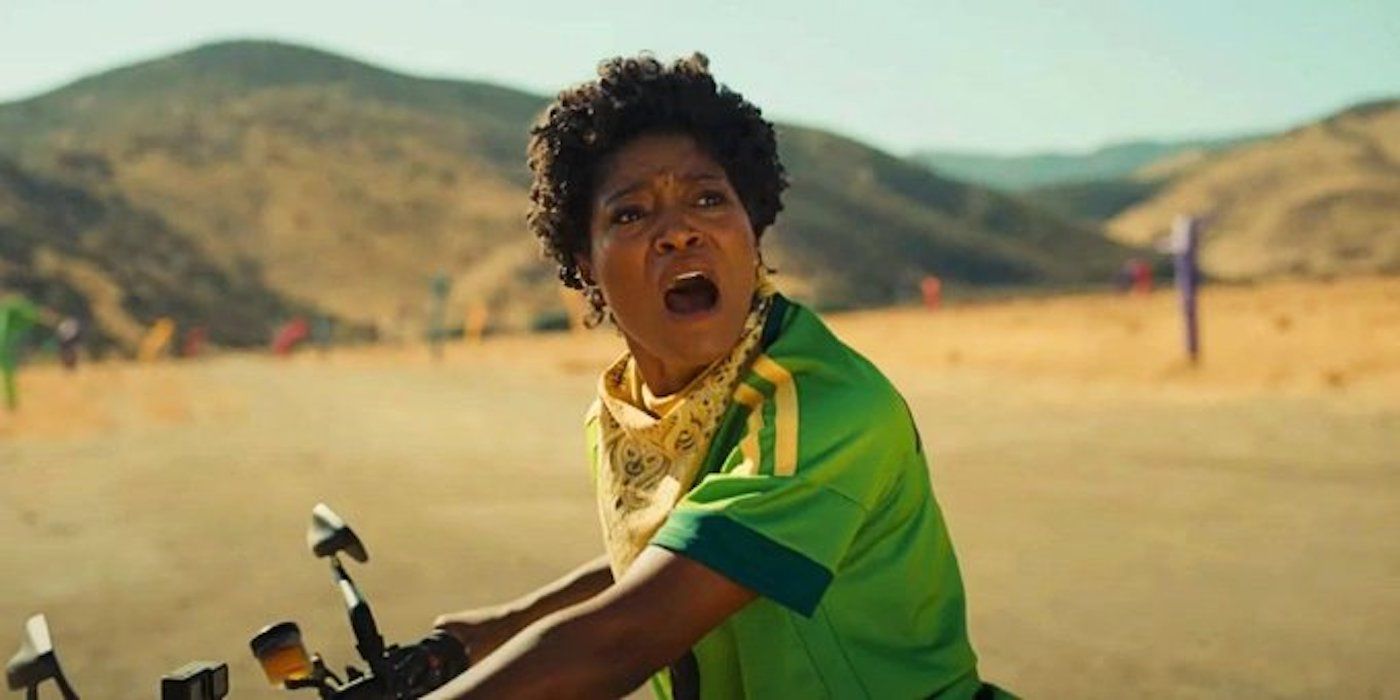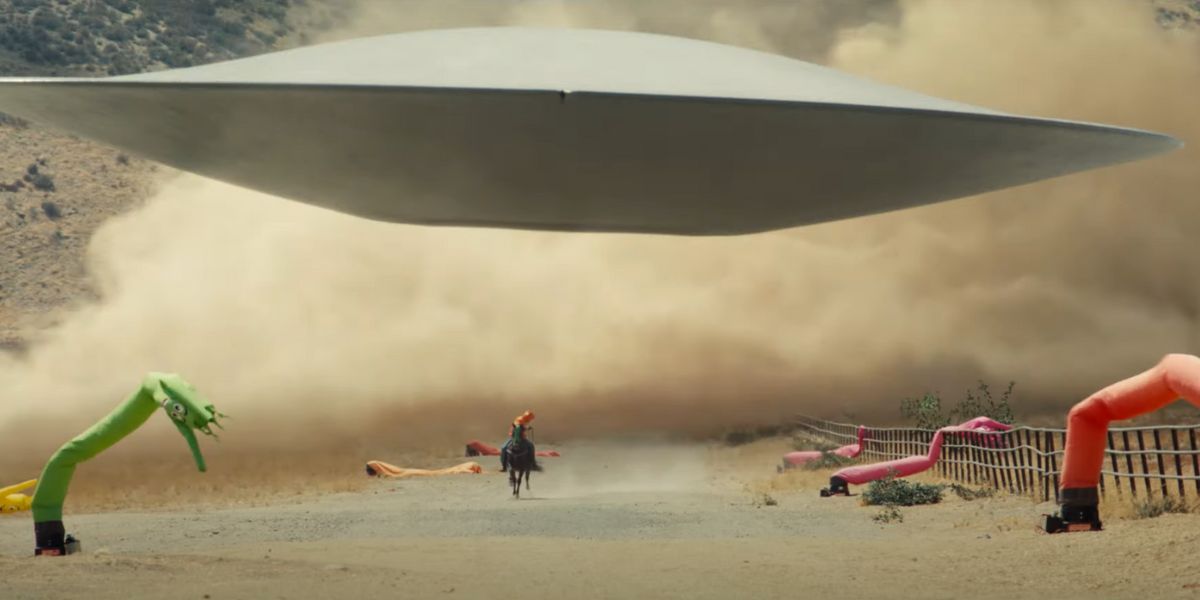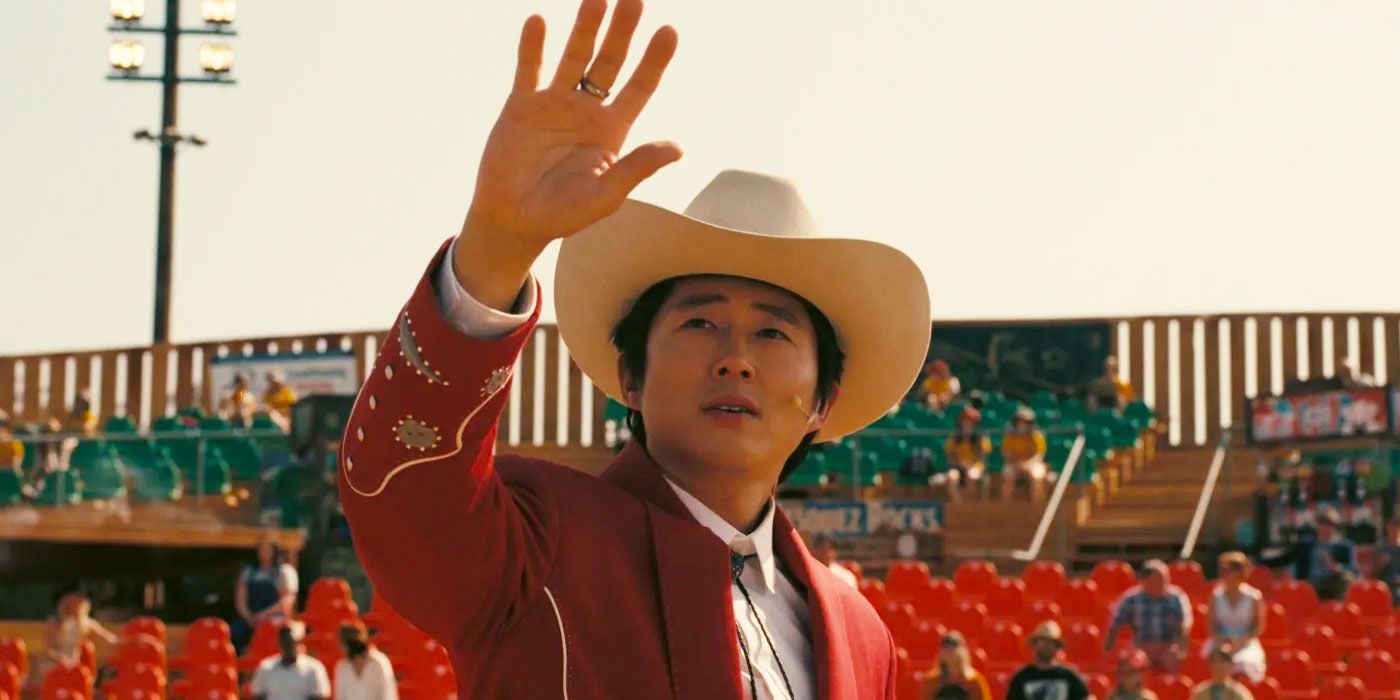After walking out of any Jordan Peele film, any range of emotions are perfectly normal. Exhilaration, curiosity, and even dread are typical reactions during an audience member’s after-theater experience. But the filmmaker’s latest film Nope has inspired a lot of confusion in many of its viewers, particularly surrounding its alien antagonist. Search no further through Reddit fan theories and hot take Twitter threads; you’ve found an answer to all of your questions about Jean Jacket right here.
The most immediately striking thing about our alien friend, outside his hunger-driven rage, is his design. Most notably, the film utilizes the common understanding of real-life UFO sightings. This particular kind of story first became popular in 1947 when a private pilot claimed to have seen nine silver crescents zooming in a formation in Washington. A reporter on the story called these phenomena “flying saucers,” coining a term still common to this day. Soon the movies would tell their own flying saucer movies; Jean Jacket’s sleek, disc-like shape is ripped straight from 1950s The Flying Saucer, the first movie to tackle UFOs albeit man-made ones. Jean Jacket resembles a typically alien flying saucer, common to science fiction films of the 1950s like The Day the Earth Stood Still and The Thing from Another World, the latter of which John Carpenter’s 1982 work The Thing is a remake of. The design has stuck with us through blockbusters like Independence Day and Spielberg’s Close Encounters of the Third Kind, proving the longevity of this imagery.
Of course, Jean Jacket subverts typical expectations of normal saucer behavior. Rather than being some rocket-fueled vehicle from another world housing bug-eyed green men awaiting escort to our human leaders, JJ is a carnivorous beast capable of consuming horses and other creatures through its open vacuum-like maw, which also acts as its eye. As Daniel Kaluuya’s character OJ discovers, eye contact with the creature attracts it. While the saucer hovers above its prey, it sucks the victim up into its mouth, an homage and explanation to the legends of alien abductions by tractor beam.
During the climactic end of the film, Jean Jacket unravels into a Kleenex-thin indescribable swirl. The implication of the story is that this is a form the creature takes when threatened, similar to a lizard extending its facial frills to intimidate or a peacock spreading its feathers to show off to potential mates. This particular look seems to take inspiration from Biblical depictions of angels. In the first chapter of his book, the prophet Ezekiel describes Ophanim, a kind of angel composed of four interlocking wheels. Traditional artistic renderings of them resemble Jean Jacket’s frilled, circle-obsessed form. Nope likely intends to imply that, like sightings of flying saucers, angelic encounters can be explained by this creature’s appearance.
But more important than JJ’s look, his role within the story tells us something thematically. The Haywood family may be afraid of the danger the carnivore poses, but they’re obsessed with turning it into something spectacular. Similarly, Steven Yeun’s character Jupe has tried to tame the creature in order to showcase it to an audience. Both groups are obsessed with turning something truly dangerous and terrifying into an epic, profitable venture. Through this, Peele points out our society’s flawed way of capturing real-life horrors. Rather than looking to save other people, we will go to self-destructive lengths to find a way to profit off of anything remotely shocking.
For Jupe, the feeling is personal; he has only been able to cope with the traumatic origins of his television career by possessing and obsessing over aspects of that legacy. His attempts to tame the creature are born out of a need to claim ownership over fear. For the Haywoods, claiming footage of the life form is about reclaiming their family’s story, regardless of the danger in which they place themselves and others. Their fascination with getting on Oprah and getting “the money shot” mirrors our own selfish desire to place ourselves at the center of a social narrative and place our mark on history.
Conceptually, JJ stands in for any kind of horrific event that might be bottled and resold as entertainment or spectacle. How many real-life terrors have a similar tale? Who hasn’t listened to a podcast about a serial killer’s victims or seen a movie about the toil of war? How often are these kinds of things tasteless and garishly inhumane rather than helpful to the victims? Director Jordan Peele uses Jean Jacket to remind us to stop looking at the skies for our self-worth and to instead focus on the people suffering around us.
The name OJ bestows upon the creature, Jean Jacket, connects to another theme of the film. Emerald explains that she was promised a horse by that name, only to have her father take it for use by the family business. This story highlights a reoccurring idea that the movie has about marginalization. For the Haywood family, photographing JJ is about more than fame and fortune; it's about reclamation of their place in Hollywood myth. The family’s ancestor appeared in the first ever sequence of images used to create a moving picture.
In real life, the identity of the jockey who appeared in that piece is unknown, even though the set of pictures, titled “The Horse in Motion,” have become an essential part of cinema history. Its use here is important; the photographer hired to capture this series of photos, Eadward Muybridge, was tasked with his own impossible shot just like the cast of Nope. In order to win a $25,000 bet for a wealthy governor, Muybridge had to photograph a horse mid-gallop with all four of its hooves off the ground. Quite a task for 1870s technology!
The jockey appearing in the photos which were later assembled into a moving picture should be celebrated as one of the first ever filmed stars. Instead, his name has faded to history’s sands as a grain of rice. The Haywood family wants to reclaim a place that is rightfully theirs as important figures in cinematic progress. Similarly, for Emerald, capturing images of Jean Jacket would be a way to reclaim the future tied to the family business that she lost when her father broke his promise and took her horse. OJ names the saucer after that horse because he recognizes that the alien is her second chance at avoiding marginalization and acquiring the freedom she was promised.
As a director who deals in broad symbolic storytelling, Peele has created another horror icon that points to the ills of society, not as a victim as the doppelgangers in his 2019 movie Us but rather as an uncontrolled force ready to be harnessed by anyone desperate enough to create a narrative around it for societal benefit. Its UFO and angel-like appearance remind us that even the things we don’t understand end up churned into popcorn entertainment for some reason, whether fame, fortune, or finding their place in the legacy of cinema.



